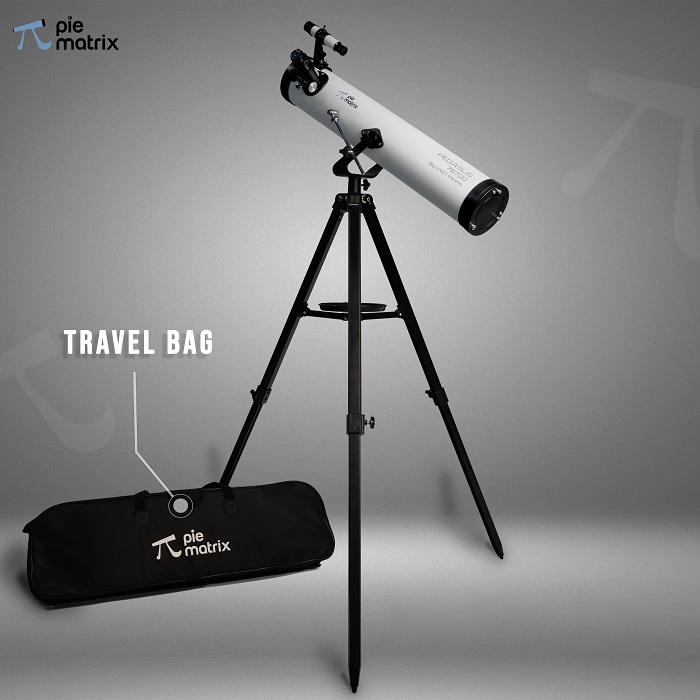If you're getting into astronomy, you might wonder what kind of telescope is best for you. Although there are many telescopes, a reflector telescope is frequently regarded as the best option for novices. These telescopes collect and focus light using mirrors, making them excellent for looking at astronomical objects like stars, planets, and galaxies.
An astronomy novice is advised to buy reflector telescopes. Reflector telescopes are less expensive than other telescopes and simpler to maintain and erect, making them ideal for aspiring astronomers.
In this post, you'll look at the best reflector telescope for beginners' many advantages and explain why they're the greatest option for beginners who want to discover the wonders of the night sky.
Description:
Searching for a top-notch, reasonably-priced telescope to aid in your exploration of the marvels of the night sky? Our 10-inch reflector telescope for sale is the only one you need!
- The best reflector telescope for beginners has a 10-inch aperture that makes it ideal for seeing dim objects like far-off galaxies and nebulae.
- Mirrors are used in the telescope's Newtonian reflector design to collect and concentrate light, creating bright, distinct images.
- High-quality glass or glass-ceramic construction in the primary mirror ensures dependable performance.
- Slow-motion settings on the equatorial mount of this telescope let you follow celestial objects as they move across the sky, making it simpler to maintain objects in view for longer periods.
- This telescope's 1000 mm focal length and f/4 fast focal ratio provide a relatively restricted field of vision, making it perfect for in-depth examinations of certain objects.
- Our 10-inch reflector telescope for sale has several extras, such as a finder scope, eyepieces with different focal lengths, and filters to improve studies of particular characteristics or objects. These add-ons can enhance your telescope experience and broaden your astronomical vistas.
Astronomers seeking a dependable and economical telescope to explore the cosmos should strongly consider purchasing this 10-inch reflector telescope now on sale. Don't pass up this fantastic opportunity!
Specifications:
10-inch aperture (25.4 cm) of a 10-inch reflector telescope
1000 mm focal length, f/4 focal ratio (this would depend on the exact design of the telescope, but a fast focal ratio like this is common for small to medium-sized reflector telescopes)
Newtonian reflector optical design reflects light to a side-facing eyepiece using a concave primary mirror and a flat secondary mirror.
Material: A lightweight, solid material like glass or ceramic is probably used to create the main mirror.
Weight: Around 10 to 20 pounds (including the mirror, mount, and other components)
Equatorial mount with controls for slow-motion tracking of objects in the sky
Field of vision: The best reflector telescope for beginners would have a relatively small field of view with a 1000 mm focal length, making it suited for detailed investigations of particular objects.
250x is about the maximum usable magnification (this depends on factors such as atmospheric conditions and the quality of the optics)
Accessories: The telescope may include extras such as a finder scope, eyepieces with different focal lengths, and filters to improve observations of particular objects or features.
Accessorize your telescope:
You can improve your stargazing experience and expand your exploration of the marvels of the night sky by adding accessories to your 10-inch reflector telescope for sale. Here are some other items to think about:
Eyepieces: The magnifications and fields of vision offered by various eyepieces vary. Once you buy this reflector telescope, possessing a collection of eyepieces with various focal lengths will enable you to view objects at various distances and with various levels of detail.
Barlow lens: A Barlow lens may double or triple the telescope's magnification without sacrificing image quality. This is especially beneficial for observing planets or another minute intricate object.
Filters: By increasing the contrast of planetary features, minimizing light pollution, or filtering out particular light wavelengths, filters can aid in improving the visibility of certain features or objects.
Mounts and tripods: A reliable mount or tripod can assist your telescope in staying still and preventing vibrations, enabling sharper and more stable observations.
Finder scope: You can more easily locate and center items in your telescope's field of view with a finder scope.
Collimation tools: Collimation tools can assist you in accurately aligning the reflector telescope's mirrors to ensure that it is operating at its best.
Astrophotography gear: If you're interested in taking pictures of the night sky, you might want to think about spending money on a tracking mount, a camera adapter, or other astrophotography gear so that you can attach your camera to your telescope and take beautiful pictures of the universe.
You may broaden your knowledge of astronomy and get the most out of your stargazing equipment by adding extras after buying a reflector telescope.
To sum up
In conclusion, a 10-inch reflector telescope has great viewing capabilities for our solar system and objects in outer space like galaxies, nebulae, and star clusters because of its big aperture and durable design. It is a well-liked choice for beginners just starting to explore the night sky because it is simple and inexpensive to operate.
The 10-inch reflector telescope is a fantastic purchase that may provide a lifetime of wonder and enjoyment, whether you are an experienced astronomer or are just getting started.
It is perfect for beginners and is the perfect choice for anyone wishing to explore the night sky because of its unmatched capacity to capture the majesty and mystique of the cosmos and its accessibility and affordability.
The Pie Matrix is an ideal starting point if you seek the greatest value on a 10-inch reflector telescope for sale. We provide many telescopes and related items, and our affordable prices guarantee you get the most for your money. Pie Matrix offers all the equipment required to begin astronomical exploration, including features like a reliable mount, simple-to-use controls, and several included accessories.
Why then wait? Invest in a 10-inch reflector telescope immediately to explore the cosmos' mysteries. Contact us to buy reflector telescopes at the best prices.
FAQs:
1. Can a reflector telescope be used in the daytime?
Using a 10-inch reflector telescope in daylight is not advised since the sun's brightness can harm the instrument's optics and endanger the user's eyes.
2. How should a reflector telescope be collimated?
A 10-inch reflector telescope's mirrors must be aligned through collimation to focus the light properly. Depending on the particular design of the telescope, the precise process for collimating a reflector telescope may vary.
Still, it usually entails using special tools to move the primary and secondary mirrors about one another. For further instructions, it is advised to consult the user handbook or ask a seasoned astronomer or telescope technician for assistance.
3. How may a reflector telescope be used?
Put the 10-inch reflector telescope on a sturdy mount or tripod before using it. Use the finder scope or manually adjust the telescope's position to align it with the object you desire to observe. Once the object is clearly in focus, adjust the eyepiece's focus. Lastly, follow the item as it glides across the sky using the mount's slow-motion controls.
4. How should I hold the reflector telescope?
Please ensure the best reflector telescope for beginners is pointing at what you want to view before looking through it. After then, put your eye in the eyepiece and change the focus until the object is clearly in focus.
It is advised to take breaks while viewing and to avoid staring intently through the telescope for long periods because this can strain the eyes. A telescope should never be used to look directly at the sun or other strong light sources, as this could permanently harm your eyes.






